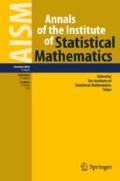Abstract
M-estimators offer simple robust alternatives to the maximum likelihood estimator. The density power divergence (DPD) and the logarithmic density power divergence (LDPD) measures provide two classes of robust M-estimators which contain the MLE as a special case. In each of these families, the robustness of the estimator is achieved through a density power down-weighting of outlying observations. Even though the families have proved to be useful in robust inference, the relation and hierarchy between these two families are yet to be fully established. In this paper, we present a generalized family of divergences that provides a smooth bridge between DPD and LDPD measures. This family helps to clarify and settle several longstanding issues in the relation between the important families of DPD and LDPD, apart from being an important tool in different areas of statistical inference in its own right.







Similar content being viewed by others
References
Basu, A., Lindsay, B. G. (1994). Minimum disparity estimation for continuous models: efficiency, distributions and robustness. Annals of the Institute of Statistical Mathematics, 46(4), 683–705.
Basu, A., Harris, I. R., Hjort, N. L., Jones, M. C. (1998). Robust and efficient estimation by minimising a density power divergence. Biometrika, 85(3), 549–559.
Bickel, P. J., Doksum, K. A. (2015). Mathematical statistics–basic ideas and selected topics (Vol. 1). Texts in Statistical Science Series, second edition. Boca Raton, FL: CRC Press.
Broniatowski, M., Toma, A., Vajda, I. (2012). Decomposable pseudodistances and applications in statistical estimation. Journal of Statistical Planning and Inference, 142(9), 2574–2585.
Chen, J., Tan, X. (2009). Inference for multivariate normal mixtures. Journal of Multivariate Analysis, 100, 1367–1383.
Dunlavy, D. M. (2005). Homotopy Optimization Methods and Protein Structure Prediction. PhD dissertation, The Graduate School of the University of Maryland, College Park.
Dunlavy, D. M., O’Leary, D. P. (2005). Homotopy optimization methods for global optimization. Technical report, Sandia National Laboratories, SAND2005-7495, Albuquerque, New Mexico 87185 and Livermore, California 94550.
Ferguson, T. S. (1996). A course in large sample theory. Texts in Statistical Science Series. London: Chapman & Hall.
Fujisawa, H. (2013). Normalized estimating equation for robust parameter estimation. Electronic Journal of Statistics, 7, 1587–1606.
Fujisawa, H., Eguchi, S. (2008). Robust parameter estimation with a small bias against heavy contamination. Journal of Multivariate Analysis, 99(9), 2053–2081.
Hong, C., Kim, Y. (2001). Automatic selection of the tuning parameter in the minimum density power divergence estimation. Journal of the Korean Statistical Society, 30(3), 453–465.
Jones, M. C., Hjort, N. L., Harris, I. R., Basu, A. (2001). A comparison of related density-based minimum divergence estimators. Biometrika, 88(3), 865–873.
Kanamori, T., Fujisawa, H. (2014). Affine invariant divergences associated with proper composite scoring rules and their applications. Bernoulli. Official Journal of the Bernoulli Society for Mathematical Statistics and Probability, 20(4), 2278–2304.
Lehmann, E. L., Casella, G. (1998). Theory of point estimation. Springer Texts in Statistics, second edition. New York: Springer-Verlag.
Lindsay, B. G. (1994). Efficiency versus robustness: the case for minimum Hellinger distance and related methods. The Annals of Statistics, 22(2), 1081–1114.
Seo, B., Lindsay, B. G. (2013). A universally consistent modification of maximum likelihood. Statistica Sinica, 23(2), 467–487.
van der Vaart, A. W. (1998). Asymptotic statistics. Cambridge: Cambridge University Press.
Warwick, J., Jones, M. C. (2005). Choosing a robustness tuning parameter. Journal of Statistical Computation and Simulation, 75(7), 581–588.
Windham, M. P. (1995). Robustifying model fitting. Journal of the Royal Statistical Society. Series B. Methodological, 57(3), 599–609.
Zhang, S., He, X. (2016). Inference based on adaptive grid selection of probability transforms. Statistics. A Journal of Theoretical and Applied Statistics, 50(3), 667–688.
Acknowledgements
The authors gratefully acknowledge the comments of two anonymous referees as well as the members of the editorial board which led to a significantly improved version of the paper. The authors are indebted to Srijata Samanta of University of Florida for her contribution toward Remark 13.
Author information
Authors and Affiliations
Corresponding author
Electronic supplementary material
Below is the link to the electronic supplementary material.
About this article
Cite this article
Kuchibhotla, A.K., Mukherjee, S. & Basu, A. Statistical inference based on bridge divergences. Ann Inst Stat Math 71, 627–656 (2019). https://doi.org/10.1007/s10463-018-0665-x
Received:
Revised:
Published:
Issue Date:
DOI: https://doi.org/10.1007/s10463-018-0665-x




